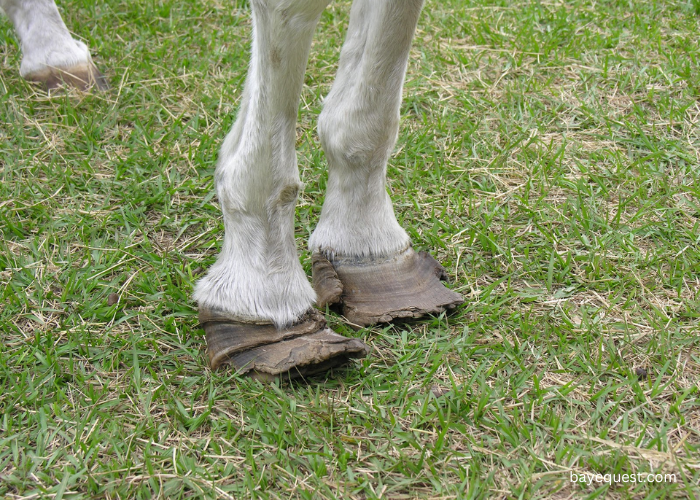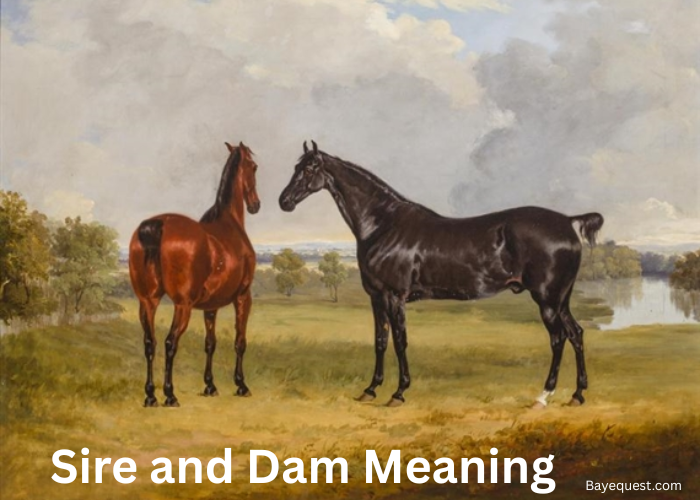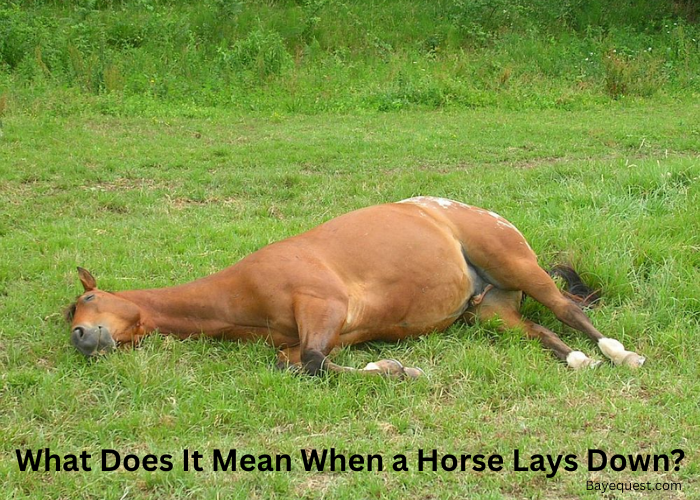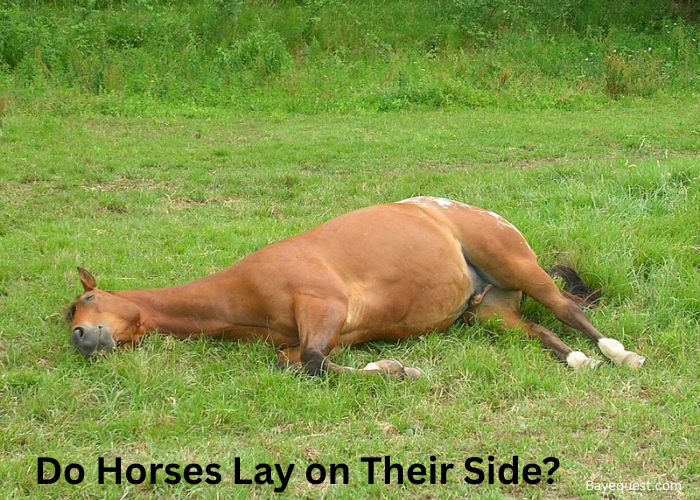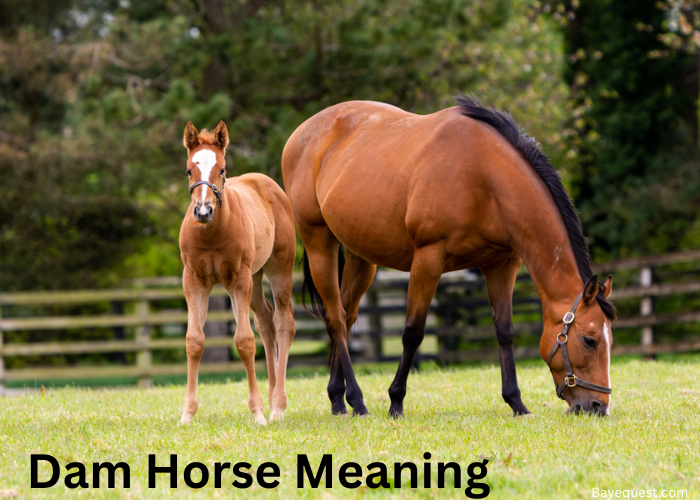Founder in horses can be a devastating condition. It’s not about a horse walking funny—it’s about pain, inflammation, and lasting damage.
You might notice your horse shifting its weight, reluctant to move, or spending more time lying down. These could be early signs.
Catching founder early is important. It can help your horse recover better and avoid a lifetime of pain and struggle.
In this guide, we’ll go through the key signs of founder and how to spot them before it’s too late.
18 Signs of Founder in Horses: Key Takeaway
- Lameness
- Shifting weight
- Reluctance to move
- Increased digital pulse
- Increased heart rate
- Heat in the hoof
- Abnormal stance
- Visible changes in the hoof
- Stretched white line
- Bleeding laminae
- Obesity
- Increased insulin levels
- Shortened stride
- Diarrhea, infection, or inflammatory response
- Regional adiposity
- Chronic abscessing
What is Founder in Horses?
Founder, also known as laminitis, is a serious condition affecting a horse’s hooves. It happens when the sensitive tissues inside the hoof become inflamed.
These tissues, called laminae, connect the hoof wall to the bone inside. When they get inflamed, it causes intense pain and makes it hard for the horse to walk or even stand comfortably.
The pain from founder can make a horse reluctant to move, and in severe cases, it can lead to permanent damage where the bone inside the hoof rotates or sinks.
Founder is a medical emergency that requires prompt attention from a vet. Early treatment can help reduce pain, control inflammation, and prevent lasting damage.
Types of Founder
Founder can take different forms, and understanding the types helps in managing the condition. There are two main types: acute and chronic founder.
Let’s break down what makes acute and chronic founder unique and how each one affects a horse.
Acute founder
Acute founder is the sudden onset of laminitis. It happens quickly and often without warning.
Symptoms include visible pain, heat in the hooves, and difficulty moving. The horse may try to shift its weight to the back legs to reduce pain in the front hooves.
Acute founder requires immediate veterinary care, as early intervention can prevent severe damage to the hoof structures.
The goal is to reduce inflammation and manage pain to prevent the condition from worsening.
Chronic founder
Chronic founder occurs when acute founder is not resolved or managed effectively. It’s a long-term condition that develops over time, often due to repeated episodes of laminitis.
Horses with chronic founder may have ongoing hoof changes. These may include abnormal hoof growth, and a more pronounced stance to alleviate discomfort.
Management of chronic founder focuses on pain relief, maintaining hoof health, and preventing further episodes.
Laminitis Vs Founder
Laminitis and founder are related terms, but they aren’t exactly the same.
Laminitis is the inflammation of the laminae, which are the sensitive structures inside a horse’s hoof that connect the hoof wall to the bone. This condition causes pain and instability, and it can vary in severity.
Founder, on the other hand, is often used to describe the more advanced stage of laminitis. It occurs when the inflammation leads to structural changes, such as the rotation or sinking of the coffin bone inside the hoof.
In simple terms, laminitis is the beginning, while founder is the more severe outcome if the condition isn’t managed in time.
Signs and Symptoms of Founder in Horses
Founder has several signs that indicate hoof pain and inflammation. The signs include:
1. Lameness
Lameness is a common sign of founder. It often presents as limping or hesitation while walking, especially on hard surfaces.
The severity can vary. Some horses barely put weight on affected hooves, while others may seem only slightly uncomfortable.
The horse’s movement changes as it tries to relieve the pain caused by inflammation. Lameness, particularly in multiple feet, warrants immediate veterinary attention.
2. Shifting weight
Horses experiencing founder frequently shift their weight from one hoof to another. This behavior helps reduce pain from the inflamed laminae.
It’s more than simple fidgeting; it’s a clear indication of discomfort. Observing this behavior early helps to ensure the horse gets prompt care.
3. Reluctance to move
Founder can make a horse reluctant to move. The pain makes every step challenging, leading to hesitation or even complete refusal to walk.
This reluctance is noticeable when the horse is asked to walk on hard surfaces or turn. Recognizing this reluctance is crucial for early diagnosis.
4. Increased digital pulse
The digital pulse becomes more pronounced in founder cases. This stronger pulse, which can be felt in the arteries near the fetlock, indicates increased blood flow due to inflammation.
Feeling a stronger pulse is a simple but important sign that something is wrong. Consulting a vet or farrier can help confirm this.
Interesting read: What is the Average Heart Rate or Pulse for a Horse?
5. Increased heart rate
Horses in pain often have an increased heart rate. This is the body’s natural response to pain and is a good indicator of discomfort.
If the heart rate is consistently elevated, it may point to serious issues like founder. Monitoring the heart rate helps gauge the horse’s condition.
6. Heat in the hoof
Heat in the hoof is an early sign of founder. The hoof, normally cool, feels warmer due to increased blood flow.
This warmth can be felt along the hoof wall or coronary band. Persistent heat in the hoof is a sign of inflammation and shouldn’t be ignored.
7. Abnormal stance
Horses with founder often stand in unusual positions to reduce pressure on their painful hooves. They may lean back or stretch their front legs forward.
This “sawhorse” stance is a distinctive sign of discomfort and should prompt a call to the vet.
8. Visible changes in the hoof
Over time, founder causes visible changes in the hoof. Ridges or rings may form, reflecting disrupted growth.
The hoof might also become deformed, appearing flatter or “dished.”
9. Stretched white line
Founder can cause the white line disease, where the hoof wall and sole meet, to become wider or stretched. This occurs due to weakened attachment between the hoof wall and coffin bone.
A stretched white line can lead to infections and indicate internal hoof issues.
10. Bleeding laminae
In severe cases of founder, small blood vessels in the laminae may rupture, leading to bleeding.
Blood spots may be visible along the white line or as bruising through the sole. This is a serious sign of internal damage and requires immediate veterinary intervention.
11. Obesity
Obesity is both a risk factor and an indicator for founder. Excess weight places stress on the hooves and can lead to hormonal imbalances.
12. Increased insulin levels
Increased insulin is often linked with founder, especially in horses with Equine Metabolic Syndrome (EMS). High insulin affects blood flow, leading to laminae inflammation.
13. Shortened stride
A horse with founder may take shorter strides, indicating discomfort in extending its legs or putting weight on its hooves. This is particularly noticeable on hard ground.
A shortened stride often points to pain, and addressing it early can help relieve the horse’s suffering.
14. Diarrhea, infection, or inflammatory response
Health issues like diarrhea or infections can trigger founder due to systemic inflammation affecting the hooves.
Conditions like severe gastrointestinal upset lead to inflammation of the laminae. Addressing these health issues promptly helps in preventing founder.
15. Regional adiposity
Uneven fat deposits, like a “cresty” neck, can indicate a higher risk for founder. Regional adiposity shows metabolic imbalances that predispose horses to laminitis.
16. Chronic abscessing
Founder can lead to chronic abscessing, where infection forms within weakened or separated areas of the hoof. Abscesses cause sudden lameness and need proper care.
Causes of Founder in Horses
Founder in horses can be triggered by a variety of factors, each affecting the health of the hooves in different ways. Below, we explore the main causes of founder that can compromise hoof health and lead to this condition.
Absorption of dietary toxins. When horses ingest excessive amounts of rich feeds, toxins can form in the digestive system. These toxins enter the bloodstream and lead to systemic inflammation. This may affect the hooves and trigger laminitis, which can progress to founder.
Pregnancy. Late-stage pregnancy can increase weight-bearing stress on the hooves. Additionally, hormonal changes during pregnancy can affect blood flow, predisposing a mare to laminitis and eventually founder.
Medication. Drugs, like corticosteroids, can negatively affect the health of the laminae by disrupting hormone balance, which alters blood flow to the hooves. This impaired blood flow can contribute to the development of laminitis and lead to founder.
Insulin resistance. Insulin resistance causes high levels of insulin in the bloodstream, which affects the regulation of sugar. This condition can lead to abnormal blood flow and inflammation in the hooves, increasing the risk of laminitis and founder.
Overeating. Overeating grain or lush pasture causes a rapid influx of sugars into the digestive system. These sugars ferment, releasing toxins that enter the bloodstream and damage the laminae, resulting in laminitis and founder if not controlled.
Exposure to black walnuts. Black walnut shavings used as bedding are toxic to horses. Even brief contact with black walnut wood can cause severe laminitis due to the release of toxins that affect circulation to the hooves, leading to founder.
Exercise surfaces. Hard or uneven exercise surfaces can lead to hoof trauma. Repeated impact on these surfaces can damage the sensitive laminae.
Colic surgery. Horses recovering from colic surgery are often at risk of founder due to systemic inflammation and altered blood flow during the recovery period. Stress and restricted movement can also contribute to hoof health problems post-surgery.
Other medical issues. Underlying health issues such as severe infections or systemic inflammation can trigger laminitis. Illnesses like severe pneumonia or gastrointestinal disorders create internal conditions that compromise the laminae and lead to founder.
Horse breed. Some breeds, like ponies, Arabians, and Morgans, are genetically more prone to metabolic issues, making them more susceptible to laminitis and founder. These breeds require careful management of diet and exercise to prevent founder.
Nail length. Long hooves create abnormal stress on the laminae by altering the horse’s gait and weight distribution. This mechanical stress damages the laminae over time.
Too much lush foraging. Access to lush grass high in sugars, especially during spring, leads to overconsumption of carbohydrates. This causes digestive disturbances and the release of toxins, leading to laminitis and potentially founder if not controlled.
Stress. Stress from transport, competition, or environmental changes releases cortisol, which affects blood flow and hormone levels. Chronic stress can lead to metabolic imbalances that increase the risk of laminitis and ultimately founder.
Retained placenta. If a mare retains the placenta after foaling, toxins can build up in her system, leading to severe inflammation. This can trigger laminitis due to compromised circulation, which can progress to founder if not treated promptly.
Diarrhea. Severe diarrhea can disrupt the digestive system, leading to toxin release. These toxins can enter the bloodstream and cause inflammation in the laminae, putting the horse at risk of laminitis and founder.
Extreme pneumonia. Severe pneumonia causes systemic inflammation, which can negatively affect the laminae. The body’s response to the respiratory infection can lead to impaired blood flow in the hooves, increasing the risk of founder.
Release of toxins internally. Systemic infections or diseases can cause the release of endotoxins into the bloodstream. These toxins disrupt normal blood flow to the hooves, leading to inflammation of the laminae and increasing the risk of founder.
Too much or extended corticosteroid use. Excessive use of corticosteroids can affect insulin sensitivity and disrupt hormone balance, impairing blood flow to the laminae. This disruption can lead to laminitis and ultimately founder if not carefully managed.
Impaired blood supply in the hoof. Any condition that restricts or impairs blood flow to the hoof can weaken the laminae. Without adequate blood supply, the laminae cannot function properly, leading to inflammation and eventual structural damage, causing founder.
Prevalence of Founder in Horses
Founder is a common issue in horses. Studies show that around 2-5% of horses get laminitis each year. Many of these cases can turn into founder if not treated. It’s one of the top causes of lameness in horses.
About 15% of horses may deal with founder at some point in their lives. Certain breeds, like Shetland ponies and Morgans, have a higher risk, with rates as high as 10-20%.
4.7% of horses with laminitis die or are euthanized. 74% recover well and are used for intended purposes.
Founder is also more common in older horses and those with metabolic issues. These numbers show how widespread and serious founder can be for horses.
Interesting read: How to Treat Hoof Cracks in Horses.
Diagnosis of Founder in Horses
Diagnosing founder involves several steps to identify the severity and location of the problem. The steps include:
Lameness exam
The first step in diagnosing founder is a lameness exam. The vet watches the horse walk and checks for any signs of pain or uneven movement.
They’ll look for stiffness, reluctance to move, or a shortened stride. This helps identify which hooves are affected and how severe the problem is.
Nerve block
To pinpoint the pain, vets often use a nerve block. They inject a local anesthetic into the area around the nerve.
If the pain goes away after the block, it confirms that the hoof is the source of the problem. It helps the vet understand exactly where the issue is located.
Blood testing
Blood tests can help in diagnosing underlying conditions related to founder, like insulin resistance or other metabolic issues.
High insulin levels can be a warning sign. These tests give the vet a better picture of what might be causing the founder and guide treatment options.
Radiographs
Radiographs, or X-rays, are crucial for understanding what’s happening inside the hoof. They show the condition of the coffin bone and its position.
If there’s rotation or sinking of the bone, it will be visible. X-rays help in assessing the severity and planning the right treatment for the horse.
Effects of Founder on the Hoof
Founder has serious effects on a horse’s hoof. The most noticeable is the separation of the laminae, which are the tissues that connect the hoof wall to the bone.
When the laminae become inflamed and weakened, the coffin bone inside the hoof can start to rotate or even sink. This rotation can change the shape of the hoof, making it look more “dished” or causing uneven growth.
Over time, you might also see rings or ridges on the hoof wall, known as “founder rings.” These changes make the hoof more prone to infections, abscesses, and long-term structural issues.
The hoof becomes painful and unstable, affecting the horse’s ability to move comfortably.
Treatment of Founder
Treating founder requires prompt and effective action to help the horse recover and prevent further damage. There are several treatment options, each aimed at reducing pain, supporting hoof health, and addressing the underlying cause.
Let’s look at the key treatments for founder in horses.
Emergency care practices
In an emergency, the first step is to reduce the horse’s pain and stop further damage. The horse should be kept in a soft, deeply bedded area to reduce pressure on the hooves.
Removing access to rich food, like lush grass or grain, helps prevent more toxins from affecting the laminae. Immediate veterinary care is crucial to stabilize the condition.
Medication
Medications are used to manage pain and inflammation. Anti-inflammatories like phenylbutazone help reduce the inflammation in the hoof and make the horse more comfortable.
In some cases, medications that improve blood flow are also given to help support the affected tissues.
Read also: How Long Does Bute Stay in Horses?
Cold water therapy
Cold water therapy is often used in the early stages of founder. The hooves are soaked in cold water or ice to reduce inflammation and pain.
Cold water helps to slow down the inflammatory response and limit the damage happening inside the hoof, making it a key part of early treatment.
Corrective trimming and shoeing
Corrective trimming and shoeing help to redistribute weight and reduce stress on the damaged laminae. A farrier works to trim the hoof to a proper angle, which can help ease pressure on the coffin bone.
Special shoes or pads may also be applied to provide more support and make the horse more comfortable during recovery.
Surgery
In severe cases, surgery may be needed. One common procedure is a deep digital flexor tenotomy, which cuts the tendon that pulls on the coffin bone.
This surgery can help reduce pain and prevent further rotation of the bone. Surgery is usually a last resort, used when other treatments haven’t worked and the horse is still in significant pain.
After Care for Foundered Horses
The after care for foundered horses is all about keeping them comfortable and managing their condition.
First, they need a soft, well-bedded area to reduce pressure on their hooves. Keeping their weight under control is also important.
Their diet should be carefully managed, with no rich foods like grains or lush grass. Regular checkups are needed to track progress, and hoof care is key.
Corrective trimming should be done regularly to maintain hoof health and help prevent any new problems. The horse might also need ongoing medications to manage pain and inflammation.
Slow, gentle exercise can help improve blood flow, but only if recommended by the vet.
Prognosis of Founder in Horses
The prognosis for founder in horses varies. About 60-70% of horses recover if founder is caught early and treated quickly.
In severe cases, where the coffin bone rotates or sinks, recovery is harder. Around 20-30% of these horses may have ongoing lameness or need special care for life.
Unfortunately, about 5-10% of severe founder cases end in euthanasia, as the pain becomes too much to manage.
The key is early treatment and good care. Horses with mild founder can often return to normal activities, but more severe cases may never fully recover.
Each horse’s prognosis depends on how quickly treatment starts and the level of damage.
How to Prevent Founder in Horses
Preventing founder in horses requires careful management.
First, control their diet. Avoid letting horses eat too much rich grass, especially in spring when it’s high in sugars.
Limit grain intake and focus on a balanced diet with plenty of fiber. Regular exercise is important to help maintain a healthy weight and good circulation.
Keep an eye on hoof health—schedule regular farrier visits to keep hooves properly trimmed. Monitor your horse for signs of insulin resistance or obesity, as these can increase the risk.
Avoid using black walnut shavings for bedding, as they can trigger founder. Good management and early intervention are the best ways to prevent this painful condition.
Conclusion
Founder is a serious condition, but spotting the signs early can make all the difference. Look out for changes like lameness, shifting weight, reluctance to move, and heat in the hooves.
These symptoms are your horse’s way of saying something is wrong. The quicker you recognize these signs, the better the chance of recovery.
Always keep an eye on your horse’s behavior and don’t hesitate to call a vet if anything seems off. Your horse depends on you to notice and act.
With care and attention, founder can be managed, and your horse can stay healthy.
Also, check out our article on equine ringbone to learn more about its causes, symptoms, and treatment options.




